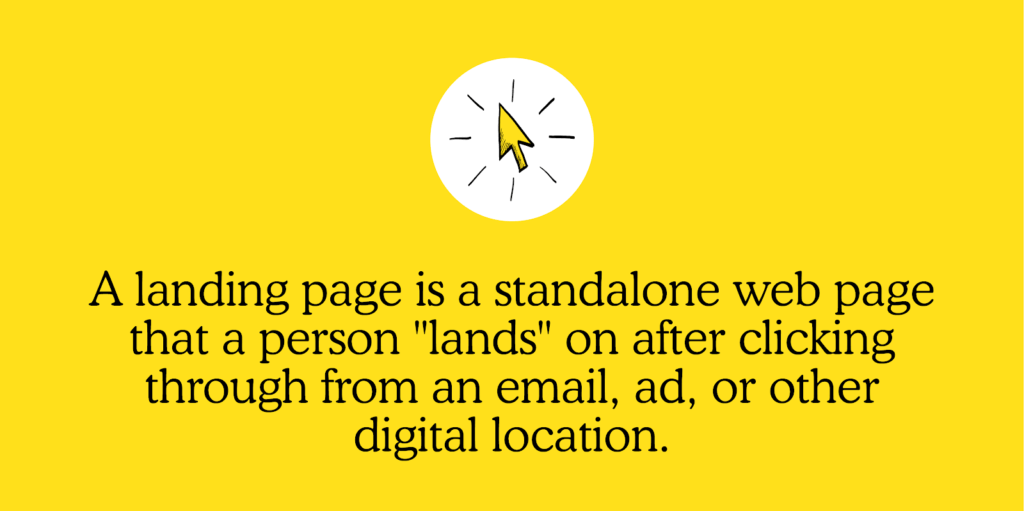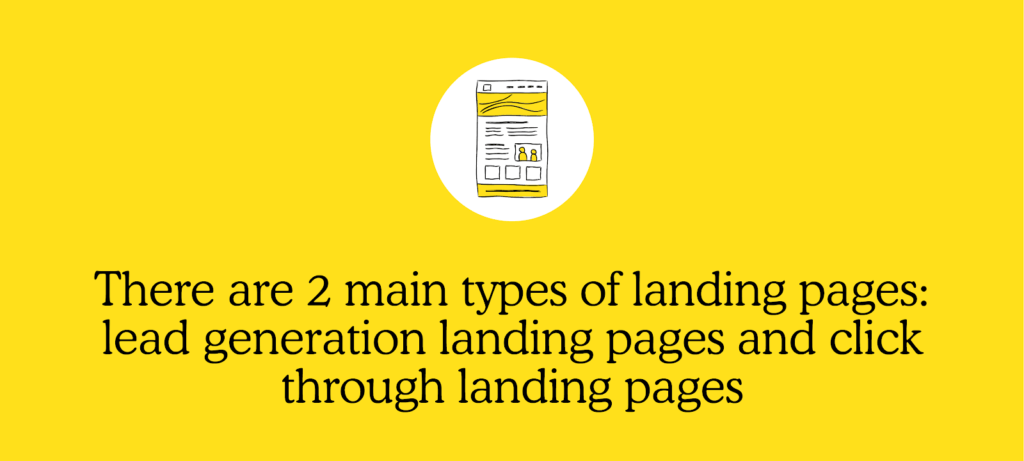
An individual “lands” on a landing page when they click across via an email, advertisement, or another digital location. Landing pages should be included in every piece of the content plan to enhance conversions and generate more visitors.
When a visitor lands on your landing page, you want them to take some sort of action, like signing up for your list or purchasing something. Your landing page has been successful in converting users if they do the precisely targeted action.
Researchers refer to this as the “paradox of choice.” That basically indicates that the more possibilities you provide individuals, the more difficult it is for them to decide and take action.
Consider that you are giving away an ebook. However, offering visitors to your landing page options like reading your blog, making a purchase, and browsing social media may reduce the likelihood of them downloading the latest ebook.
On the other extreme, having too many options may confuse your consumers, prompting them to hesitate and do nothing. That’s why it’s crucial to concentrate on only one call to action (CTA) as opposed to three or four.
That’s why a landing page needs validation for optimal conversion, maintaining a clear visual structure and value proposition.
landing page vs homepage
Initially, some doubt the necessity of landing pages as their primary goal is to drive viewers to the homepage. However, while boosting homepage traffic is beneficial, it’s less likely than landing pages to drive conversions.
Customers are encouraged to travel to a number of various destinations from home pages, which offer a wealth of data. If someone visits your homepage with a specific objective, browsing through multiple other services and products might deter them.
The homepage’s primary goal is to direct visitors to pages with the needed data. By providing the page that the consumer wants and making that clear, landing pages cut out the middle step.
Click here to discover about AWS.

Why Use Landing Pages?
You did a fantastic job developing your identity and making a website to reflect it. Ensure that all of your hard effort results in sales right now. Landing pages are undoubtedly the correct way to go if you’re searching for a lead generation solution.
A landing page is a fantastic tool for increasing visitors, enhancing SEO, and establishing your brand. Approximately 68% of B2B businesses use landing pages to generate leads for afterward possible conversions.
Thankfully for you, 44% of these clicks are directed toward home pages, which is a bad tactic, we’re going to discuss. Visitors are directed to landing pages that promote a particular commodity, service, or deal and push them to take action. This could be your chance to increase conversions and expand your clientele.
If landing pages have become so important, why are not they utilized by every business? It is a misconception that they are challenging to develop and preserve. Building an effective landing page is more concerned with meeting the needs of the customer than with being stunning.
Not all landing pages are created equal. Broad categories may be utilized to categorize them, which will be discussed below.

Types of Landing Pages
In design, landing pages serve either to generate leads or direct visitors to the next action.
Lead generation landing page
This kind of landing page sometimes referred to as “lead gen” and “lead capture” pages, concentrates on gathering lead information. In simple terms, it gathers data about your clients.
It requests user information such as names, email addresses, and phone numbers in exchange for a good or service. Even more particular information, such as their ages or jobs, might be requested. In this manner, you can get in touch with leads and foster their interest in your company.
There is yet another use for this information. You can learn from your contacts from the data you gather. Your marketing efforts can therefore be directed toward those who fulfill those criteria and are more likely to convert. This might bring up your return on investment (ROI), in particular when you operate paid advertising campaigns.
In this manner, the information that lead generation pages gather helps to enhance and maximize the effectiveness of your marketing plan. You can use it to tailor your ads to your audience in order to save money on advertising to prospects who are unlikely to convert.
Lead-generation landing pages are an important resource for your company since they give you information about your target market’s characteristics and communication methods. Think about including one on your website if lead nurturing is a top goal for you or if you want to know who your customers are.
Click-through landing page
Call-to-action buttons are the main focus of click-through landing sites, as opposed to lead generation pages, which feature forms. The visitors are directed to a page where they can carry out the desired action by pressing the button.
For example, clicking “schedule a demo” may lead to the scheduling page, “order X now” to the payment page, and so on.
Click-through landing pages are frequently found on e-commerce websites as well as websites that prioritize generating sales right away over gathering data from users. These landing pages typically incorporate compelling content, such as product specifications or user testimonials, in addition to the CTA button to further interest and engage potential consumers.
Squeeze Page
A squeeze page is used to gather information, much like a lead-generation page. It’s commonly used near the sales process peak, opposite a lead-generation page, aiming to collect email addresses for a general mailing list.
They have brief, straightforward landing pages with strong headings and little else. The clear call to action ensures the reader knows what to expect from the click-through. Additionally, besides the brief form, include a link for the next step and an option to leave.
Sales Page
Designing a sales page is often the most challenging as it no longer solely aims at lead prospecting. It serves as a tool at the bottom of the sales funnel, persuading customers to make a purchase—a distinct goal from a simple request and incentive scheme.
Crafting the page, from copy to design, demands tact and a deep understanding of your client’s needs and sales process stage. At this point, you run the risk of either overselling and losing the business, or underselling and keeping the client.
Here is where your layout and communication techniques must involve some good old-fashioned selling skills.
The page’s size depends on what you’re selling and the information needed to convey its value to the audience. Regardless of length, a thorough pitch is crucial to convince the audience to click and make the purchase.
Infomercial
You might believe that infomercials are a remnant of late-night broadcasting in the 1990s, yet many companies effectively adopt their sales approaches into their digital strategy, especially in the form of niche landing sites.
Unlike squeeze or lead-generation pages, which are distinguished through their succinctness, advertisement landing pages advise viewers of a long, clear story while using copy that is reminiscent of the emotional and excited behaviors of those late-night sales masters. The goal is to encourage people to keep scrolling and make a purchase.
Splash Page
Splash pages are perhaps the most straightforward kind of landing page and may be utilized at any stage of your sales channel. They often contain just a few words of prose, one or two bold graphics, and extremely basic language—usually a statement or a straightforward “yes” or “no” request.
Before accessing your website, they might require the visitor to confirm their age or select their preferred language. They simply offer people extremely basic information before joining your website and are not intended to gather data or create leads.
Viral Landing Page
The main goal of viral landing pages is to increase brand recognition. Although companies frequently include connections to a company website or other online pages, they typically display them discreetly and without being overwhelming.
The most important factors here are content and social media sharing functionality. The content should be interesting and/or helpful sufficient to draw readers in and encourage them to share the page. The content may consist of textual text, videos, photographs, or even interactive games.
Microsites
As the term implies, a microsite is a special, little website. Developers created it for a particular campaign or with a single, focused sales objective in mind. Even with multiple pages, it is still referred to as a type of landing page because it dedicates itself to a certain component of marketing and sales operations. Web advertisements support microsites or cooperate with TV ad campaigns.

The importance and benefits of a landing page
Landing pages differ from any other page on your website because they focus on specific, immediate goals that will help you achieve the outcomes you want. In addition to raising conversion rates, enhancing paid advertising efforts, and producing fresh audience data, landing pages can:
Benefits
- Increasing your reputation: Users often respect messaging that is straightforward and emphasizes the benefits of what you’re delivering. a well-thought-out landing page shows your customers that you have their best interests in mind. Furthermore, they provide spaces for social proof elements like client testimonials for your products or solutions.
- Enhance your reputation: Take benefit of all that you’ve learned because you’ve been putting in a lot of effort to build a digital identity. It’s the result of maintaining continuity with your website’s appearance, functionality, design, and content. Building a powerful and distinctive brand has several benefits. A powerful brand identity can assist users in recognizing you in the future, engaging with your retargeting efforts, or promoting you to their friends whenever they aren’t instantly converted.
- Generate leads: Both kinds of landing pages can enhance revenue for your company and produce leads. Because landing pages are more carefully targeted, they might place more emphasis on conversion rate than on expertise and material. However, you can highlight the benefits of your products and services to a specialized audience already engaged with your offerings, thus increasing sales.
- Increase traffic: Through a landing page, you may improve website traffic even if generating leads is not your primary objective. This will raise brand awareness and enable consumers to discover more about your company. Your landing pages can more specifically target natural traffic whenever they are optimized for SEO, which will boost the likelihood that users will convert.
Landing pages are obviously important for your marketing plan. And it’s best if you have additional landing pages that have been optimized. However, that begs the issue of how to optimize them and what to optimize them for.
